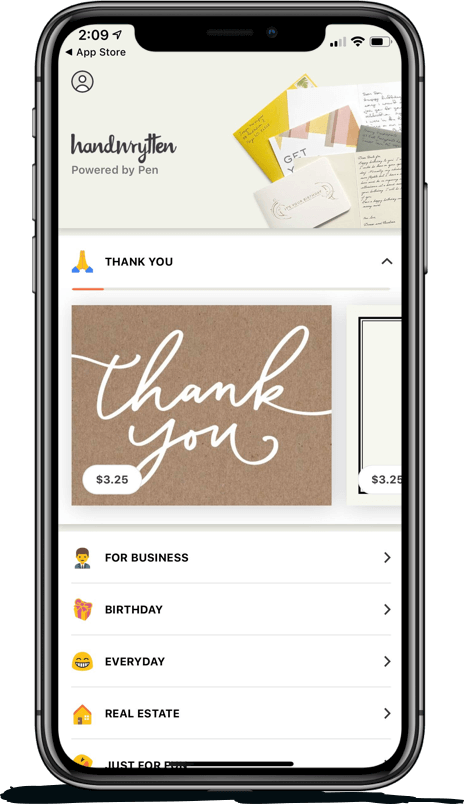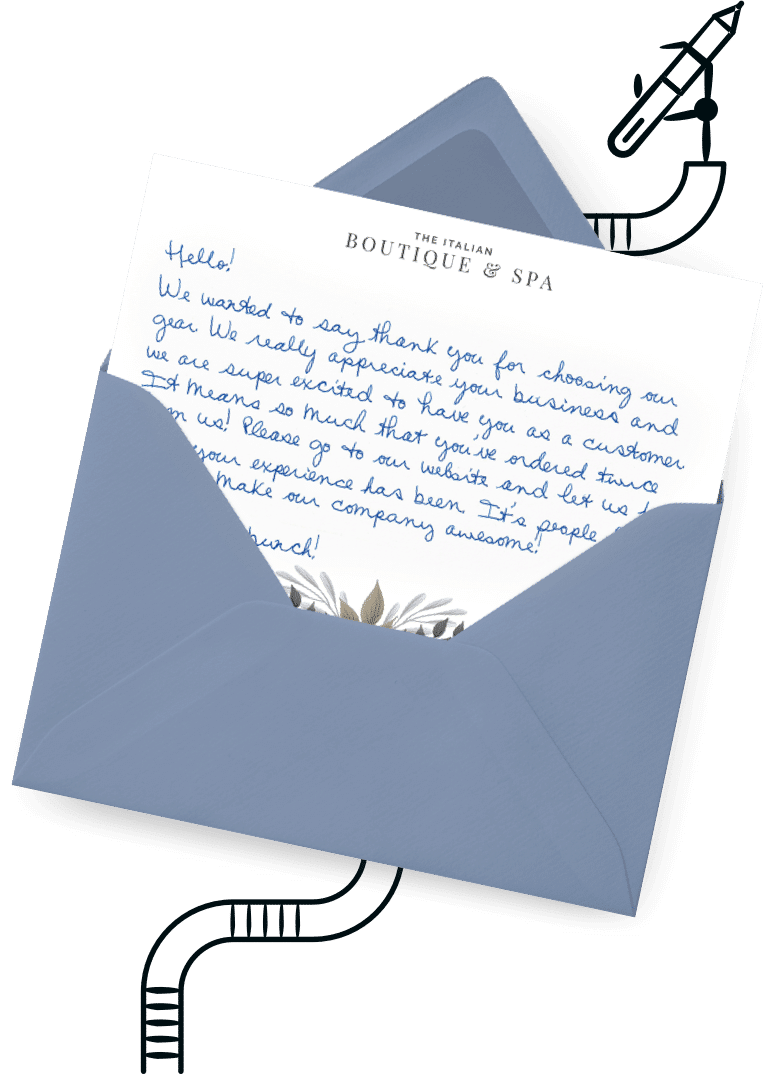
9280 S. Kyrene Rd.
Suite 134
Tempe, AZ 85284
Phone: +1 (888) 284-5197
Email: contact@handwrytten.com



You have been subscribed. Thank you!
For both small and large businesses, creating real connections with clients can drive new sales, retain loyal customers, and move your company forward. However, when you’re short on time, staff, or resources, building a personal relationship with every customer might seem impossible. Discover how greeting cards can add a personal touch to your business relationships and learn when to send cards for different occasions.
If your company’s marketing efforts typically center on digital strategies such as text and email marketing, you might wonder how sending greeting cards can truly make a difference. While digital strategies can help you reach a wide range of customers, the connections that you make through online marketing don’t have quite the same impact as sending personal notes.
After all, your customers are already drowning in digital messages. On average, office workers receive nearly 150 emails per day, and 35- to 44-year-olds send and receive more than 1,500 text messages per month. Printed mail and advertisements generally have low rates of return. Nearly half of all junk mail remains unopened, and the average response rate for pre-printed mail is a dismal 4.4 percent.
While your emails and texts can easily get lost in the digital shuffle and your pre-printed mail may go straight into the trash or even get delivered when you need it to be, handwritten mail tends to stand out. Handwritten notes get 4 times the response rate of pre-printed mail, which means that your recipients will almost certainly get the message. In addition, recipients tend to respond positively to personal notes from businesses, leading to more calls, sales, and bookings.
Taking the time to make personal connections can also help your business stick in your customers’ minds.
When you want to cut through the clutter and create meaningful connections with your customers, greeting and other penned notes and cards are a smart choice. Not only can sending handwritten notes help your messages avoid the recycling bin, but taking the time to make personal connections can also help your business stick in your customers’ minds.
Quality. If you’re going the extra mile by sending personalized greeting cards to your customers, don’t stop before you’ve reached the finish line. Try high-quality notes rather than sending inexpensive, run-of-the-mill cards. After all, you want the quality of your cards to communicate the value that you deliver to your customers.
Design. When it comes to style, choose a design that aligns with your company’s brand. Businesses with an elegant, formal brand might opt for a more traditional design, while companies with a friendly, whimsical brand might select a quirkier style. Though your business cards can feature your company’s logo, keep in mind that an overly corporate look may prevent you from forging the personal connection that you’re seeking. For example, one Handwrytten client, a large car manufacturer, leaves their logo off the card entirely!
Personalize. To emphasize the individual nature of your message, avoid using pre-printed messages. Instead, use handwritten notes that reveal the value you place on your client relationships. Include messages that are customized for each recipient. Including the names of products or services purchased is an easy way to add the “personal touch” to an automated-handwritten note campaign.
Automate. Writing and mailing customized greeting cards is time-consuming, but with a service such as Handwrytten, you can essentially automate the entire process. Stop spending time writing, rewriting, worrying that your handwriting isn’t legible, and making trips to the post office. Handwrytten has a solution that seamlessly blends personality with technology. Simply compose a message digitally, select a card and writing style, and your customers will receive beautifully handwritten notes that will resonate.
Before sending greeting cards to prospects or clients, make sure that you’re following a few essential rules of thumb. By doing so, you’ll avoid offending or confusing clients and you will build solid relationships that drive sales.
Tip #1: Stay current. Check your list to ensure that you’re sending the notes to your contacts’ current addresses. You can save time by pulling the information directly from your customer relationship management (CRM) system. You may also link the database to your Handwrytten account. Consider including the recipients’ titles as a sign of respect.
Tip #2: Think about timing. A well-intentioned note may not have the positive impact that you want if you wait too long to send it out or if your note seems out of touch. To maximize the opportunity, plan well in advance and always aim to have your cards stay ahead of the curve. As by their nature, handwritten cards take time for the post office to deliver. There’s a reason we call it “snail mail”. Some Handwrytten users send clients follow-up notes using the Handwrytten app right as they’re walking out of their sales meetings. They know that the process of a handwritten note automatically spaces out their messaging strategy perfectly.
Tip #3: Make it special. If you truly want to make your greeting cards stand out, include something special. If it’s a birthday card for a valued employee, the card itself might be gift enough. But adding a gift card to your customized note is a great way to get a customers’ attention while brightening their day and providing more value. However, don’t add just any old gift card to your note; take care to keep it with your brand. A gift card to a high-end restaurant may work well for an upscale brand, while a gift card to a neighborhood coffee shop may be better for companies with a local focus.
The beauty of a business greeting card is that you can send notes to your clients whenever inspiration strikes. To avoid missing key opportunities to connect be sure to send out cards on a few important occasions.
When to Send: Within a week of acquiring a new customer.
Who to Include: New customers.
How to Personalize: Mention the context of your new relationship and next steps or related expectations.
No matter how many clients your business gains per month, adding a new client to your roster is a cause for celebration. There’s no need to keep the festivities in-house, however. Show your new customers how much you appreciate them by sending out welcome cards, but avoid sending a card signed “with love”; that might be a bit too much appreciation for a first-time customer.
Since welcome cards should make new customers feel special, pay attention to how you customize your note. Mention the context of the professional relationship, such as customers signing up for your loyalty program. Then touch on what they can expect from your company, from seasonal sales to new product debuts to special events.
You can even encourage new customers to take steps to pursue or a call-to-action. Use customer profiles to determine which prompts to use. You might suggest items to purchase, point the way to FAQs, or ask them to register for an event.
Finally, leave new customers with everything they need to connect with your company. Include your business phone number, website, or links to your social media accounts. This will assist new customers so they know exactly where to find answers. Consider including a business card for an extra personal touch.
Don’t wait to send out welcome cards to new customers. Aim to connect with clients while your company is still fresh in their minds or within a week of acquisition.
When to Send: Within a week of a major purchase or project completion.
Who to Include: Current customers.
How to Personalize: Specifically mention the purchase or project and offer value-added tips.
Regardless of how long your customers have been loyal to your business, they deserve gratitude and appreciation. Committed clients drive the success and future growth of your business.
To show your customers how much you appreciate their business, send out thank you cards after major purchases or upon completing substantial projects. Although you can use a simple template to frame your note, try to include as many personalized details as possible. This extra step is especially important for customers who have made substantial investments in your company.
When a major event happens internally, your team might be busy handling all of the details. However, don’t let your team’s schedule cause a delay in sending out thank you cards. Make a point of sending out cards within a week of a large purchase. Communicate to your customers know that you appreciate them and respect their time.
The best business thank you notes don’t end with an expression of gratitude. Take your thank you cards to the next level by politely mentioning that you’d appreciate it if your satisfied customers shared your company with their colleagues. You can even offer a referral fee or guide customers to your referral program to encourage continued loyalty.
When to Send: Three weeks before the holiday.
Who to Include: Current, past, and prospective customers.
How to Personalize: Include a holiday special that’s related to the customer’s status.
While welcome cards and thank you notes are ideal for current customers, holiday cards can be sent to a much larger group. Plan to send cards to everyone from prospective customers to clients you haven’t heard from in months.
You ensure that your business remains relevant by sending holiday cards to prospects, especially if potential clients are reconsidering their vendors or finalizing their budgets for the upcoming year. By sending holiday cards to current customers, you’ll cement your existing relationship and encourage long-term loyalty. When you include past or dormant customers on your holiday card list, you’ll have the potential to resume a once-vibrant relationship simply by reaffirming your personal connection.
Plan to send out all holiday cards at least three weeks before the holiday. If you wait too long, your card may not arrive until after the holiday, making your company appear disorganized or disingenuous.
For end-of-year holidays and New Year’s cards, consider summarizing your relationship with the client over the past year. Holiday cards offer a great opportunity to remind your customers how much you appreciate them while adding to the holiday spirit.
While you may be hesitant to pair important holidays with aggressive marketing, you can include subtle sales messages in your holiday cards. Drive long-term loyalty among current customers or prompt prospects to make their first purchases. This can be done by featuring holiday specials or by pointing them to a landing page on your website.
When to Send: Three weeks before the birthday.
Who to Include: Current customers.
How to Personalize: Include a time-sensitive special discount.
Birthdays may sound too personal for business relationships, but, in reality, they’re the perfect occasion to connect with your clients. You may not know your clients’ exact ages, and it’s a good idea to keep track of their birth dates. Simply acknowledging birthday months is a great strategy when sending out celebratory cards. If you do have their exact birth dates, sending cards for milestone birthdays are a great way to curry favor.
As a general rule, aim to send out birthday cards about three weeks before the birthday or at least a week before the birthday month begins. If you stick to this general schedule, you won’t have to worry that about the card arriving after the fact. Erring on the early side means your note will arrive before they receive cards from family, friends, and other businesses.
In the birthday card, offer your best wishes and include a personalized note that mentions something that you’ve worked on together or a major purchase that the client has made in the past 12 months. You can also add value and drive sales by including a time-sensitive discount. Whether you consider it a birthday present or an annual sale, include a customized code to make it clear that the discount is for your client only.
Whether you’re preparing for the holiday season or planning ahead for birthdays, you’ll find many opportunities to connect with your client base with greeting cards. Save time and resources by sending Handwrytten cards, and start building deeper, more meaningful relationships with your clients.


Scale your handwritten outreach, creating positive impressions and long lasting bond.
Sign Up Today!


Over 100 designs to choose from or design your own. Our online card customizer makes it simple.
Check Out Our Cards!





